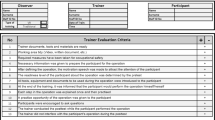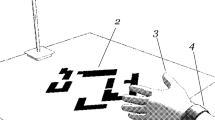Abstract
This paper reports the results of an investigation carried out to analyse and evaluate the influence of haptic-enabled virtual assembly (VA) training with respect to real assembly tasks. The aim was to determine how well virtual assembly training transfers knowledge and skills to the trainee in order to improve their real-world assembly performance. To demonstrate this, a comprehensive analysis and evaluation of the influence of VA training on the real assembly performance is presented. This influence is assessed in terms of the effectiveness and efficiency when performing the real assembly task after undergoing VA training. The study considers the use of three training modes and several assembly tasks with increasing complexity and number of parts. The results indicate a significant improvement (of up to 80 %) in the real assembly performance of subjects who undertook VA training first when compared to those trained conventionally. Moreover, haptic-enabled VA training led to greater levels of effectiveness than without haptics. The results also revealed that the effectiveness of VA training depended on assembly task complexity, i.e. the greater the task complexity, the greater the effectiveness. Consequently, maximum VA training effectiveness was obtained with a combination of haptic-enabled VA training and high-complex assembly tasks.
Similar content being viewed by others
References
Sanderson AC (1991) “Representations for assembly sequences”, computer-aided mechanical assembly planning, 148th edn. Kluwer Academic, Norwell, pp 129–162
Fletcher CA, Ritchie JM, Lim T (2012) The generation of machining process plans using a haptic virtual reality system. Proceedings of the ASME 2012 International Design Engineering Technical Conference & Computers and Information in Engineering Conference, p 231–236
Yusof Y, Latif K (2013) Computer aided process planning: a comprehensive survey. Advance in Sustainable and Competitive Manufacturing Systems, p 389–400
Dewar RG, Carpenter ID, Ritchie JM, Simmons JEL (1997) Assembly planning in a virtual environment. Innovation in technology management—the key to global leadership. PICMET: Portland International Conference on Management and Technology, p 664–667
Gupta R, Whitney D, Zeltzer D (1997) Prototyping and design for assembly analysis using multimodal virtual environments. Computer-Aided Design 29(8):585–597
Xia P, Lopes AM, Restivo MT (2013) A review of virtual reality and haptics for product assembly (part 1): rigid parts. Assem Autom 33(1):68–77
Hills AM (2004) Daratech study names Delmia Corp. as market leader in digital manufacturing process management. Dassault Systems: http://www.3ds.com/
Thornton J (2009) At Ford, ergonomics meets immersive engineering. EHSToday, June 2015, http:// ehstoday.com/health/ergonomics/ford-ergonomics-simulation-0409/
Sung RC, Ritchie JM, Lim T, Sivanathan A, Chantler MJ (2013) The evaluation of a Virtual-Aided Design Engineering Review (VADER) system for automated knowledge capture and reuse. Proceedings of the ASME 2013 International Design Engineering Technical Conferences and Computers and Information in Engineering Conference. p V02BT02A030-V02BT02A030
Lin F, Ye L, Duffy VG, Su CJ (2002) Developing virtual environments for industrial training. Inf Sci 140(1–2):153–170
Ong SK, Mannan MA (2004) Virtual reality simulations and animations in a web-based interactive manufacturing engineering module. Comput Educ 43(4):361–382
Arjona-López MA, Hernández-Flores C, Gleason-García E (2003) An intelligent tutoring system for turbine startup training of electrical power plant operations. Expert Syst Appl 24(1):95–101
Vora J, Nair S, Gramopadhye AK, Duchowski AT, Melloy BJ, Kanki B (2002) Using virtual reality technology for aircraft visual inspection training: presence and comparison studies. Appl Ergon 33(6):559–570
Basdogan C, Ho CH, Srinivasan MA (2001) Virtual environments for medical training: graphical and haptic simulation of laparoscopic common bile duct exploration. IEEE/ASME Trans Mechatron 6(4):269–285
Arbabtafti M, Moghaddam M, Nahvi A, Mahvash M (2011) Physics-based haptic simulation of bone machining. IEEE Trans Haptics 4(1):39–50
Wang J, Lu WF (2012) A training system for virtual surgical incision with haptic playback. Virtual Phys Prototyping 7(4):231–242
Prasolova-Forland E, Fominykh M, Darisiro R, Morch AI (2013) Training cultural awareness in military operations in a virtual afghan village: a methodology for scenario development. 46th Hawaii International Conference on System Sciences, p 903–9012
Adams RJ, Klowden D, Hannaford B (2001) Virtual training for a manual assembly task. Haptics-e 2(2):1–7
Chen YH, Yang ZY, Wang YZ (2005) Haptic modeling for a virtual coordinate measuring machine. Int J Prod Res 43(9):1861–1878
Fischer A, Vance JM, Vo DM (2009) Haptic feedback to guide interactive product design. ASME-AFM 2009 World Conference on Innovative Virtual Reality (WINVR2009) February 25–26, 2009, Chalon-sur-Saône, France
Lim T, Medellín H, Sung R, Ritchie J, Corney J (2009) Virtual bloxing-assembly rapid prototyping of near net shape. In: World Conference on Innovative VR, 2009-02-25–2009-02-26, Chalon-sur-Saone, France
Klatzky R, Lederman SJ, Metzger VA (1985) Identifying objects by touch: an expert system. Percept Psychosics 37(4):299–302
Lim T, Ritchie JM, Dewar RG, Corney JR, Wilkinson P, Calis M, Desmulliez M, Fang J-J (2007) Factors affecting user performance in haptic assembly. Virtual Real 11(4):241–252
Ritchie J, Lim T, Sung RS, Corney J, Rea H (2008) Part B: the analysis of design and manufacturing task using haptic and immersive VR—some case studies. Product Engineering Tools and Methods Based on Virtual Reality, p 4507–4522
Vo DM, Vance JM, Marasinghe MG (2009) Assessment of haptics-bases interaction for assembly tasks in virtual reality. Third Joint Eurohaptics Conference and Symposium on Haptic Interfaces for Virtual Environment and Teleoperator System, Salt Lake City, UT, USA, p 494–499
Bordegoni M, Cugini U, Belluco P, Aliverti M (2009) Evaluation of a haptic-based interaction system for virtual manual assembly. Virtual Mixed Real 5622:303–312
Iglesias R, Prada E, Uribe A, Garcia-Alonso A, Casado SGT (2007) Assembly simulation on collaborative haptic virtual environments. Proceedings of 15th International Conference in Central Europe on Computer Graphics, Visualization and Computer Vision, p 241–247
Gonzalez-Badillo G, Medellin-Castillo HI, Lim T, Ritchie JM, Garbaya S (2014) The development of a physics and constraint based haptic virtual assembly system. Assem Autom 34(1):41–55
Tching L, Dumont G, Perret J (2010) Interactive simulation of CAD models assemblies using virtual constraint guidance. Int J Adv Manuf Technol 4(2):95–102
Brough JE, Schwartz M, Gupta SK, Anand DK, Kavetzky R, Pettersen R (2007) Towards the development of a virtual environment-based training system for mechanical assembly operation. Virtual Real 11(4):189–206
Iliano S, Chimienti V, Dini G (2012) Training by augmented reality in industrial environments: a case study. Proceeding of 4th CIRP Conference on Assembly Technologies and System, Ann Arbor, USA
Webel S, Bockholt U, Engelke T, Gavish N, Olbrich M, Preusche C (2013) An augmented reality training platform for assembly and maintenance skills. Robot Auton Syst 61(4):398–403
Goldwasser MH, Motwani R (1999) Complexity measures for assembly sequences. Int J Comput Geometry Appl 9(4):371–417
Ghandi S, Masehian E (2015) Review and taxonomies of assembly and disassembly path planning problems and approaches. Comput Aided Des 67–68:58–86
Boud AC, Baber C, Steiner SJ (2000) Virtual reality: a tool for assembly? Presence 9(5):486–496
Oren M, Carlson P, Gilbert S, Vance JM (2012) Puzzle assembly training: real world vs virtual environment. Virtual Reality Short Papers and Posters (VRW), 2012 IEEE, p 27–30
Gardner H (1983) Frame of mind: the theory of multiple intelligences. Basic Book, New York
Philbin DA, Ribarsky W, Walker N, Hubbard CE (1998) Training in virtual environments: analysis of task appropriateness. Proceedings of the IEEE 1998 Virtual Reality Annual International Symposium
Xia P, Lopes AM, Restivo MT (2011) Design and implementation of a haptic-based virtual assembly system. Assem Autom 31(4):369–384
Garbaya S, Zaldivar-Colado U (2007) The effect of contact force sensations on user performance in virtual assembly tasks. Virtual Real 11(4):287–299
Jayaram S, Jarayam U, Kim YJ, DeChenne C, Lyons KW, Palmer C, Mitsui T (2007) Industry case studies in the use of immersive virtual assembly. Virtual Assembly 11(4):217–228
Author information
Authors and Affiliations
Corresponding author
Rights and permissions
About this article
Cite this article
Gallegos-Nieto, E., Medellín-Castillo, H.I., González-Badillo, G. et al. The analysis and evaluation of the influence of haptic-enabled virtual assembly training on real assembly performance. Int J Adv Manuf Technol 89, 581–598 (2017). https://doi.org/10.1007/s00170-016-9120-4
Received:
Accepted:
Published:
Issue Date:
DOI: https://doi.org/10.1007/s00170-016-9120-4




